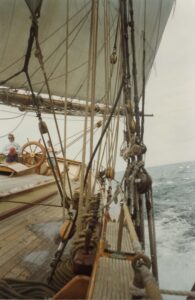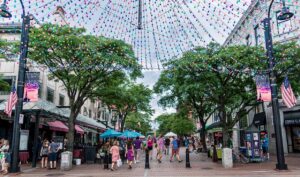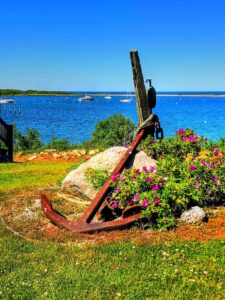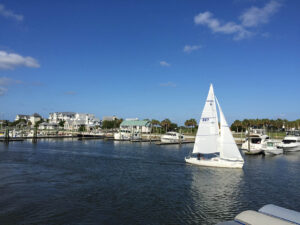There’s a sense of deja vu the first time stepping ashore in Lahaina. One may think their GPS malfunctioned and routed their yacht to the Florida Keys rather than the Hawaiian island of Maui. For Front Street in Lahaina, has all the familiar trappings of Duval Street in Key West. Restored and faux 19th century architecture now house bars, restaurants, art galleries and souvenir shops chockablock. In season, the population can quadruple due to tourists visiting the city. But if one can look past the hawkers selling snorkeling adventures and surfing lessons, a peek at a fascinating slice of Hawaiian history awaits.
The island of Maui was settled by Polynesians from the Marquesas who paddled and sailed their canoes across vast tracts of the Pacific Ocean around 400 A.D. They were followed by a wave of Tahitian settlers about 350 years later. The Tahitians laid the foundations of Hawaiian language, religion and culture. After the island’s founding, a hereditary group of chieftains governed different sections of Maui. The chiefdom in West Maui was called Lele, and ruled from the site of present day Lahaina.
Maui was also a demi-god of the Polynesians and a rascal in Hawaiian mythology. It was Maui who used his great fish hook to pull the Hawaiian Islands up from the ocean floor. And it was Maui who snared the sun with his ropes to slow it down in its path to create longer days in the summer for raising crops and drying bark cloth.
Through the 16th century Maui continued to prosper under a strict adherence to a four-tier caste system, a complex land tenure system and a society goverened by kapu or taboos. The first documented European that
there is documentary evidence of coming to Maui is the English explorer Capt. James Cook who just sailed by looking for an anchorage in the autumn of 1778. Eight years later, French Admiral De Galaup landed just south of where the town of Kihei is located today.
In 1779, Capt. Cook was on the big island of Hawaii where he met with a young chief with a string of 12 names. Rather than continually reciting his litany of names, he was come to be known as Kamehameha. Kamehameha had a vision, first to unite the clans of the island of Hawaii under one king (himself ) and then to conquer all the Hawaiian Islands and rule them as his united kingdom. He accomplished the first task in 1791. Maui fell to King Kamehameha four years later after an assault by almost 1,000 war canoes and 10,000 of the king’s soldiers. The only island not to succumb to the new king was Kauai. Even so, the Kingdom of Hawaii was declared as complete in 1810, and Kamehameha I ruled as an absolute monarchy.
After the king died in 1819, his son, Prince Liholiho, was crowned King Kamehameha II. The following year he moved his kingdom’s capital from the western shore of the big island to the western shore of Maui and the town of Lahaina. Lahaina remained the capital of the Kingdom of Hawaii for 25 years. During that time two groups with very different philosophies became prominent: whalers and missionaries.
In the early 1790s Yankee whaling fleet from New Bedford, Mass., expanded into the Pacific Ocean off the coast of Peru in its ever increasing need to meet the demand for sperm oil for lamps and lubrication. As soon as they opened a new fishery, the whalers hunted the sperm whales to extinction, and new hunting grounds needed to be found. In 1820, the first New Bedford whaling ship hunted sperm whales on the Japan Ground. It was located halfway between Hawaii and Japan, and the Hawaiian Islands became a perfect waypoint for stocking up on fresh local produce and water and making ship repairs and finding new crew. Honolulu and Lahaina became the main Pacific ports for the North Pacific whaling fleet. Although Lahaina did not have a well-protected harbor like Honolulu, Lahaina Roads had good holding and became a busy anchorage.
In 1824, more than 100 whaling ships anchored off Lahaina, and 30 years later it rose to 400 ships per year. Lahaina was the nexus of the prosperity of whaling and the seat of government of the king. Brothels, taverns and inns sprung up along Front Street. The sailors were quite pleased with that arrangement, but the Christian missionaries were not.
Just as the whalers came from New England, so did the missionaries of Maui. Presbyterian and Congregationalist missionaries arrived in Lahaina in the early 1820s. These early missionaries frowned upon the practice of sailors taking Hawaiian women back to their ships for their pleasure. But the sailors chafed at the intervention of these pious Christians, so the whalers attempted to demolish the house of a reverend and even shelled the town with their cannon in retaliation. In response to the cannon fire, a fort was built along the waterfront of Lahaina, and the reconstructed ruins of its walls are an attraction to this day.
Eventually, the whalers and missionaries learned to live with each other. The missionaries went about their business of spreading Christianity and “civilizing” the native population. That included inventing a written version of the Hawaiian language, which had been learned by word of mouth. The oral traditions of the Hawaiian culture could now be put on paper and passed on to future generations. Since much of the Hawaiian culture involved a religion of Polynesian gods and mythology, it was difficult for the Protestant faith to take hold. Through perseverance though, there were 13 churches on Maui by 1870, and all of them had Hawaiian pastors. The pastors were trained at Lahainaluna Seminary, founded in 1831, which remains as Lahaina’s high school and is known as the oldest high school west of the Rockies.
By the 1870s, the whaling industry on Maui was gone. Petroleum oil had been discovered in Pennsylvania and “black gold” supplanted the use of whale oil. The Confederate navy and its raiders destroyed many of the Yankee whalers during the Civil War. Sugar cane and pineapples and the plantation system used to grow those crops soon provided enormous profits to the descendants of the original missionaries. Today, whaling in Lahaina is limited to whale watching during the December -to- May season.
Visitors still continue to come to Lahaina by sea. The town has a small, picturesque harbor, but the majority of slips are used by commercial boats providing sportfishing, diving, snorkeling, whale watching and sailing trips. But the Lahaina Yacht Club has saved the day by providing seven free moorings just outside the harbor entrance. Just pick up a mooring ball, dinghy ashore at the harbor and walk the few short blocks to the yacht club for dinner and a few libations while watching the sunset.
Capt. Jeff Werner, a licensed USCG Master, has sailed professionally throughout the world. He is also the Diesel Doctor, helping to keep your boat’s fuel clean and bright. For more information, call 239-246-6810 or visit MyDieselDoctor.com. All Marinalife members receive a 10% discount.
Planning to cruise the Hawaiian Islands?
These are must-have resources:
“Cruising Guide to the Hawaiian Islands” by Bob and Carolyn Mehaffey, Paradise Cay Publications, 2007
“United States Coast Pilot 7” from the National Ocean Service, 2013
Also visit:
noonsite.com/Countries/Hawaii
hawaiiboatingsource.com/safeharbor.html
For more marinas and an online cruising
guide, visit yachtpals.com/maui
Capt. Jeff Werner has been in the yachting industry for over 25 years. In addition to working as a captain on private and charter yachts, both sail and power, he is a certified instructor for the USCG, US Sailing, RYA and the MCA. He is also the Diesel Doctor, helping to keep your yacht’s fuel in optimal condition for peak performance. For more information, call 239-246-6810, or visit MyDieselDoctor.com. All Marinalife members receive a 10% discount on purchases of equipment, products and supplies from Diesel Doctor.





